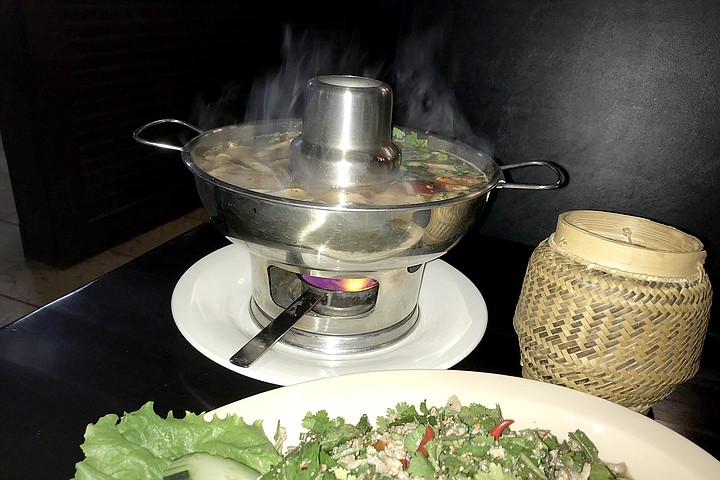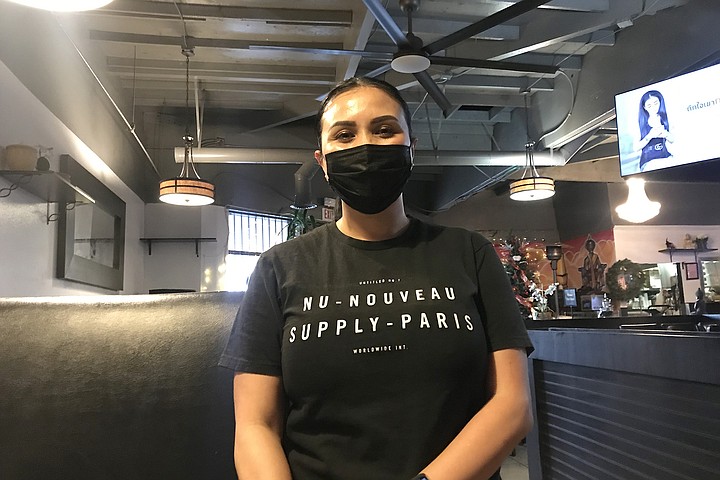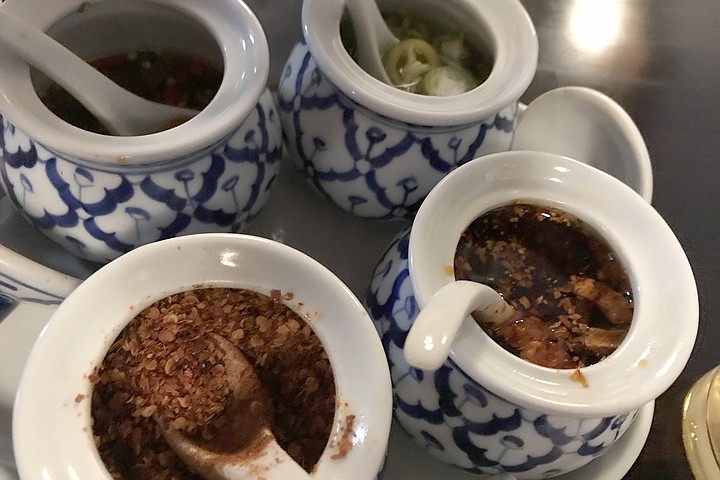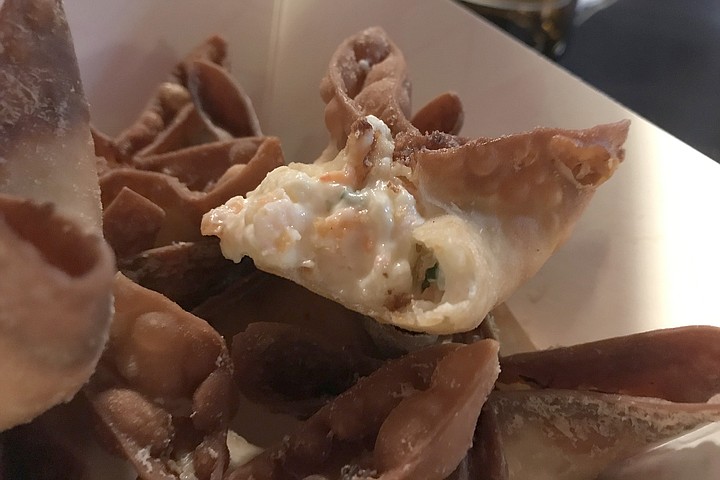 Facebook
Facebook
 X
X
 Instagram
Instagram
 TikTok
TikTok
 Youtube
Youtube

Night has clanged down on City Heights like an emergency curtain at a movie theater. It’s easy to get lost in this gloom once you’re out of the #7 bus, but, just past Happy Bubbles Car Wash, I spot the place my friend Kim says “hasn’t ‘a-Lao’d’ itself to become watered down and westernized. Only thing,” he warns, “watch out when you choose your spice strength there. A 10 means a 10.”
“Sit anywhere,” says Paula, this self-assured gal wearing a black “Nu-Nouveau Supply-Paris” teeshirt. The furniture is dark and smart. I’m getting a feeling of prosperity here. Chandeliers. Expensive framed mirrors. Shiny polished ebony tabletops. Paula leaves a menu. It’s a relief to find that the prices aren’t as fancy as the furniture.

Place advertises “Lao-Thai food.” Is there a difference? I hold that thought as I spot crab rangoon — crispy pastries squished around crab meat. Costs $7.95 for half a dozen. Nice starter. But I’m also hankering for some tom yum kung (spicy shrimp soup) to spark the cockles of my heart with heat. The question Paula puts to me is, how much spiciness to go for? “We have a scale of 0-50 here,” she says. “We can go all the way, but not many do and live.” She laughs. So do I, nervously. While I’m umming and aaahing about it, she hauls over this four-pot spice collection. And for the first time, I get a lesson in spices.
“You have to know what spices to use. It’s about heat, but also taste. This first pot is fish sauce; it’s a substitute for salt. It gives flavor to plain rice. Then this is vinegar with serrano pepper slices, good for flavoring noodles or fried rice. This third pot is crushed dry chili. We use it on everything except papaya.” She fills up an entire deep scoop and scatters it over the tom yum soup. “Start off with one scoop and move up. After the fourth scoop, you are on your own.” Then she reaches to the last bowl of hot stuff. “And this is the chili oil. Spicy with a smoky flavor. Good with pork belly or soup, but not with fresh salad or larb or papaya salad. Too strong. It will erase their light flavors.”

Ten minutes later, I have made up my mind, with Paula’s input, natch. “How about larb?” she suggested. “I am Lao. It is our national dish.”
I mention tom yum. On this cold night, I have the hots for that hot, spicy soup with shrimp bobbing about in it. “Not a problem,” says Paula. “Even though tom yum is, well, not Lao.” Turns out it’s Thai. Not the same. Result is, I get one of each: the steaming tom yum soup, and this fresh cool dish of larb, a kind of salad mixed with ground pork and wicked red peppers. It costs $12.95. The tom yum (“boiled mix”) soup is $13.95. “So you want it a little spicy?” Paula says. I sure do. With tom yum you’ve got to, to get the thrill. Most times, Thai restaurants undersupply the spiciness because they worry customers aren’t used to hot peppers. I’m not saying I’ve got the toughest taste buds in the world, but I do like a bit of kick.
Time to chow. I start off with the larb pork salad, because, hey, it is Laos’s National Dish, and, Paula says, this gives you a good vibe.
“Larb salad is special to us. I am Lao. We are very sentimental about it. If you go back in history, the reason it is called ‘larb’ is this: it is more like a beautiful wedding ceremony or a birthday when you eat it. It means ‘luck,’ or ‘fortune’ in the ancient Lanna language. We eat it to say ‘Thank you,’ and when we want to give our blessing. So when you eat that together, it’s like ‘OK. Nothing’s going to stop us now.’”

And it is delicious. It’s ground marinated pork (or you could have chicken or beef, or duck, or faux meat), with a little bit of citrus, nam pla (fish sauce), herbs, mint, lemon grass. It is supposed to be light-flavored and refreshing. Paula: “Our food is not westernized here at Ban Lao (‘Laotian House’). Larb is more of a country people’s dish.” One famous larb version uses the eggs of red ants to zip up the colors and the flavor. But mostly, Paula says, Laotian cuisine is simple. “Our basics are papaya salad, fish sauce, larb, and sticky rice. Kids want a lot of deep-fried everything, but the rest of us like most things fresh.”
And tom yum soup? “It’s a Thai dish. Same with curries. They are Thai. From the south. They got them from India. The main difference between Lao and Thai food? Our countries are neighbors, but Laos is landlocked. Laos is about vegetables and pork and chicken and maybe freshwater shrimp and fish, and sticky rice. The Thais have the coasts. They get all the seafood.”

It works well. Light and spicy larb pork salad, then the shining hotpot with its cargo of shrimp and veggies — mainly mushrooms — and sticky rice. It gets richer the further down you go. A scoop of crushed dry chilis onto both, and I’ve got me a kick-ass hot soup and salad. It sure warms up the night.
PS. Okay. Discover I’ve spent, like, a lot. But I check the menu again. Next time, I can fill up on a bowl of tom kha soup ($6.95) and a woven basket of sticky rice for $2. That should stop the wallet leak.


Night has clanged down on City Heights like an emergency curtain at a movie theater. It’s easy to get lost in this gloom once you’re out of the #7 bus, but, just past Happy Bubbles Car Wash, I spot the place my friend Kim says “hasn’t ‘a-Lao’d’ itself to become watered down and westernized. Only thing,” he warns, “watch out when you choose your spice strength there. A 10 means a 10.”
“Sit anywhere,” says Paula, this self-assured gal wearing a black “Nu-Nouveau Supply-Paris” teeshirt. The furniture is dark and smart. I’m getting a feeling of prosperity here. Chandeliers. Expensive framed mirrors. Shiny polished ebony tabletops. Paula leaves a menu. It’s a relief to find that the prices aren’t as fancy as the furniture.

Place advertises “Lao-Thai food.” Is there a difference? I hold that thought as I spot crab rangoon — crispy pastries squished around crab meat. Costs $7.95 for half a dozen. Nice starter. But I’m also hankering for some tom yum kung (spicy shrimp soup) to spark the cockles of my heart with heat. The question Paula puts to me is, how much spiciness to go for? “We have a scale of 0-50 here,” she says. “We can go all the way, but not many do and live.” She laughs. So do I, nervously. While I’m umming and aaahing about it, she hauls over this four-pot spice collection. And for the first time, I get a lesson in spices.
“You have to know what spices to use. It’s about heat, but also taste. This first pot is fish sauce; it’s a substitute for salt. It gives flavor to plain rice. Then this is vinegar with serrano pepper slices, good for flavoring noodles or fried rice. This third pot is crushed dry chili. We use it on everything except papaya.” She fills up an entire deep scoop and scatters it over the tom yum soup. “Start off with one scoop and move up. After the fourth scoop, you are on your own.” Then she reaches to the last bowl of hot stuff. “And this is the chili oil. Spicy with a smoky flavor. Good with pork belly or soup, but not with fresh salad or larb or papaya salad. Too strong. It will erase their light flavors.”

Ten minutes later, I have made up my mind, with Paula’s input, natch. “How about larb?” she suggested. “I am Lao. It is our national dish.”
I mention tom yum. On this cold night, I have the hots for that hot, spicy soup with shrimp bobbing about in it. “Not a problem,” says Paula. “Even though tom yum is, well, not Lao.” Turns out it’s Thai. Not the same. Result is, I get one of each: the steaming tom yum soup, and this fresh cool dish of larb, a kind of salad mixed with ground pork and wicked red peppers. It costs $12.95. The tom yum (“boiled mix”) soup is $13.95. “So you want it a little spicy?” Paula says. I sure do. With tom yum you’ve got to, to get the thrill. Most times, Thai restaurants undersupply the spiciness because they worry customers aren’t used to hot peppers. I’m not saying I’ve got the toughest taste buds in the world, but I do like a bit of kick.
Time to chow. I start off with the larb pork salad, because, hey, it is Laos’s National Dish, and, Paula says, this gives you a good vibe.
“Larb salad is special to us. I am Lao. We are very sentimental about it. If you go back in history, the reason it is called ‘larb’ is this: it is more like a beautiful wedding ceremony or a birthday when you eat it. It means ‘luck,’ or ‘fortune’ in the ancient Lanna language. We eat it to say ‘Thank you,’ and when we want to give our blessing. So when you eat that together, it’s like ‘OK. Nothing’s going to stop us now.’”

And it is delicious. It’s ground marinated pork (or you could have chicken or beef, or duck, or faux meat), with a little bit of citrus, nam pla (fish sauce), herbs, mint, lemon grass. It is supposed to be light-flavored and refreshing. Paula: “Our food is not westernized here at Ban Lao (‘Laotian House’). Larb is more of a country people’s dish.” One famous larb version uses the eggs of red ants to zip up the colors and the flavor. But mostly, Paula says, Laotian cuisine is simple. “Our basics are papaya salad, fish sauce, larb, and sticky rice. Kids want a lot of deep-fried everything, but the rest of us like most things fresh.”
And tom yum soup? “It’s a Thai dish. Same with curries. They are Thai. From the south. They got them from India. The main difference between Lao and Thai food? Our countries are neighbors, but Laos is landlocked. Laos is about vegetables and pork and chicken and maybe freshwater shrimp and fish, and sticky rice. The Thais have the coasts. They get all the seafood.”

It works well. Light and spicy larb pork salad, then the shining hotpot with its cargo of shrimp and veggies — mainly mushrooms — and sticky rice. It gets richer the further down you go. A scoop of crushed dry chilis onto both, and I’ve got me a kick-ass hot soup and salad. It sure warms up the night.
PS. Okay. Discover I’ve spent, like, a lot. But I check the menu again. Next time, I can fill up on a bowl of tom kha soup ($6.95) and a woven basket of sticky rice for $2. That should stop the wallet leak.